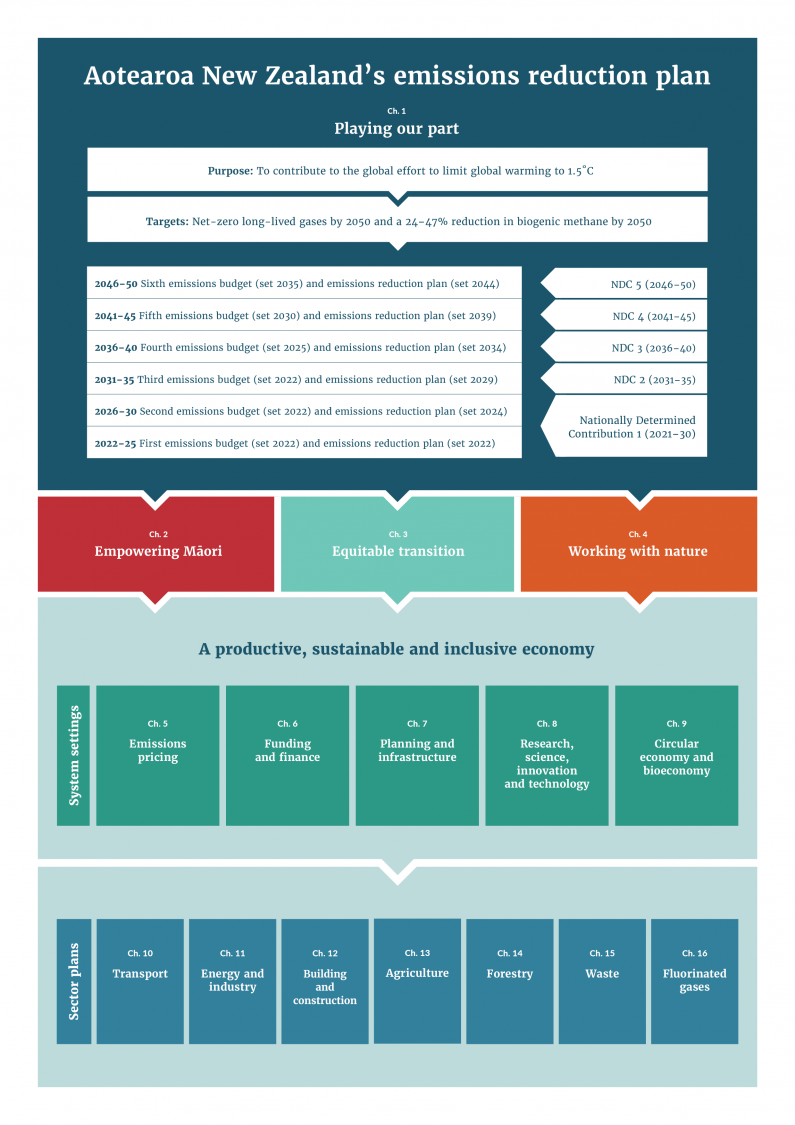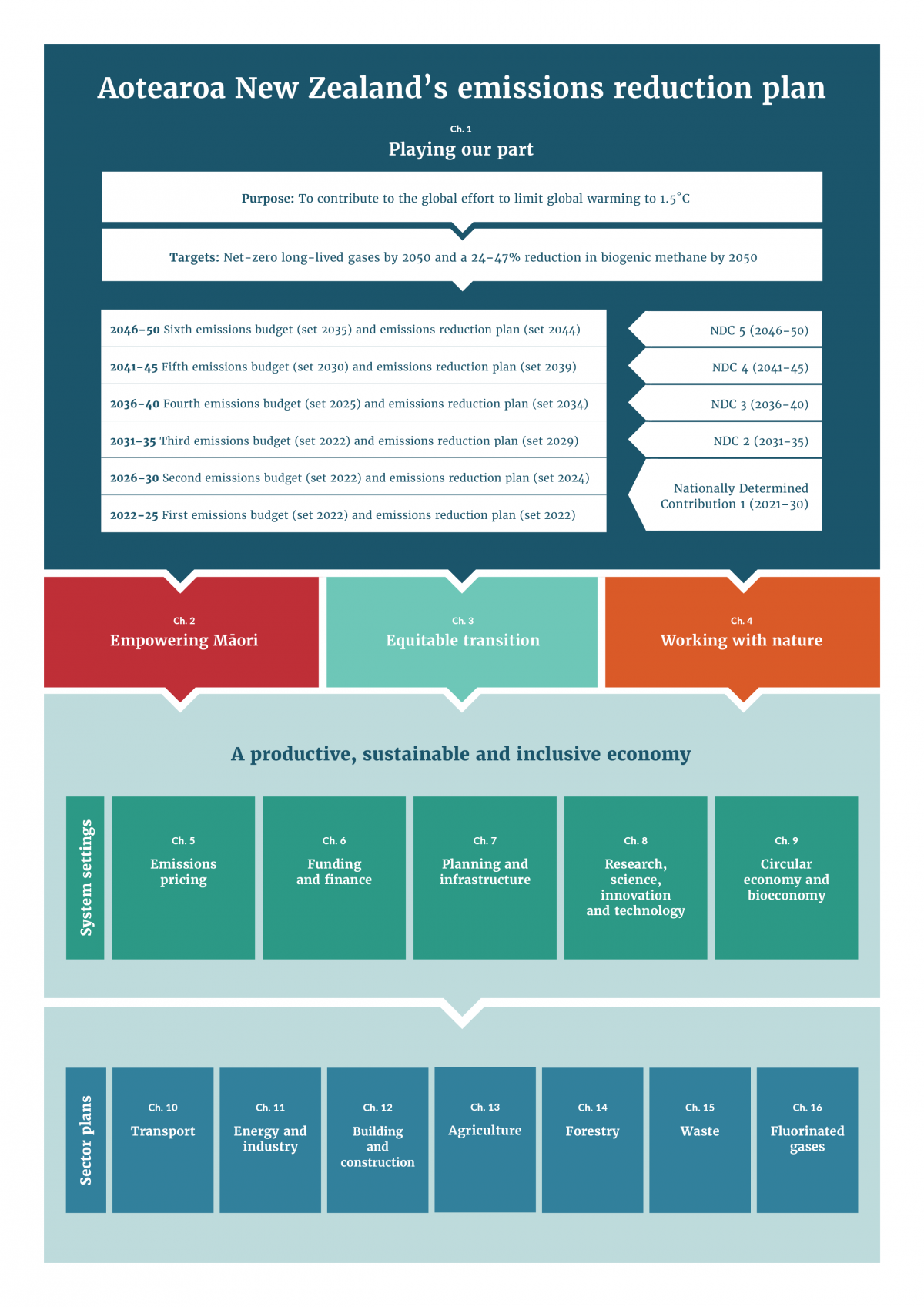Executive summary

The challenge of transitioning to net-zero emissions presents the single greatest opportunity that our country has had, in at least a generation, to develop our economy into one that is much more productive, much more sustainable and much more inclusive than the one we have today.
And that challenge is as urgent and important as it has ever been. The science tells us that limiting global warming to 1.5 ̊C above pre-industrial levels gives us the best chance of avoiding the worst effects. As temperatures have already risen more than 1 ̊C, we must act now to prevent further atmospheric warming and the catastrophes that come with it.
This document is Aotearoa New Zealand’s first emissions reduction plan. It contains strategies, policies and actions for achieving our first emissions budget, as required by the Climate Change Response Act 2002.
In doing so, it also outlines how we intend to play our part in global efforts to limit warming to 1.5 ̊C above pre-industrial levels.
This plan responds to the recommendations of He Pou a Rangi – Climate Change Commission (the Commission) in its report, Ināia tonu nei: a low emissions future for Aotearoa.
It also builds on the Productivity Commission’s 2018 report, Low-emissions economy [PDF, 8.6 MB]; the cross-government response (commonly known as the Climate Action Plan 2019*); and the Interim Climate Change Committee’s 2019 reports, Accelerated electrification [PDF, 1.5 MB] and Action on agricultural emissions [PDF, 2.5 MB].
This plan also draws on a significant number of departmental strategies and work programmes, such as the Ministry of Transport’s 2021 report, Hīkina te Kohupara – Kia mauri ora ai te iwi – Transport Emissions: Pathways to Net Zero by 2050 [PDF, 4.1 MB].
Over the past five years, these reports, recommendations and plans have driven the most ambitious government climate change work programme ever. This has resulted in:
These changes have already lowered the trajectory of Aotearoa New Zealand’s future greenhouse gas emissions – but not enough to put us on a path towards net zero.
That is why this plan is so important. It is the first statutory plan, under the Climate Change Response Act, to require the Government to act to reduce emissions right across the economy and support all New Zealanders to make the most of the transition and seize the opportunity to lower the cost of living and improve living standards.
Some major actions over the next few years will include:
This executive summary briefly outlines New Zealand’s strategy for reducing emissions, the principles that guide that strategy, and the key steps we are taking to put that strategy into action over the coming years.
* Transitioning to a low-emissions future: The Government response to the Productivity Commission’s Low Emissions Economy Report [PDF, 302 KB]
Below is a map outlining Aotearoa New Zealand’s emissions reductions strategy. It also points you to the chapters of the emissions reduction plan, where you can dive into as much or as little detail as you want.
The strategy, and this plan to execute it, is based on five principles:
The following outlines how those principles inform the design of the emissions reduction strategy and plan. The final section of this executive summary, Making the plan happen, describes the lines of accountability and responsibility for delivering the actions in this plan.


Purpose: To contribute to the global effort to limit global warming to 1.5˚C
The climate crisis is the greatest challenge of our time. The science tells us that limiting global warming to 1.5 ̊C above pre-industrial levels gives us the best chance of avoiding the worst effects.
Therefore, the purpose of the strategy, also required under the Climate Change Response Act 2002, is for Aotearoa to contribute to the global effort to limit temperature rise to 1.5 ̊C.
Delivering on that purpose means setting long-term emissions reduction targets to 2050.
Those long-term emissions reduction targets will be met through a series of ‘stepping stone’ emissions budgets and emissions reduction plans that include the policies and strategies for achieving those budgets.
Our emissions budgets for the next 14 years will be (Mt CO2-e):
| First emissions budget (2022-25) | Second emissions budget (2026-30) | Third emissions budget (2031-35) | |
|---|---|---|---|
| All gases, net (AR5) | 290 | 305 | 240 |
| Annual average | 72.5 | 61.0 | 48.0 |
A new emissions reduction plan will be published before the start of each emissions budget period.
Each emissions reduction plan will be informed by advice provided by the Commission, which will take new data and information into account. The second and third emissions budgets may be revised if the criteria in the Climate Change Response Act are satisfied and a revision is recommended by the Commission.
Alongside our domestic emissions budgets are our nationally determined contributions to the global effort to reduce emissions under the Paris Agreement.
The emissions reduction plan focuses on how we will reduce emissions, but we also need to adapt to climate impacts that are already locked in. This will primarily be addressed through the national adaptation plan. Each sector chapter has identified areas where action can be taken to improve resilience to climate change while reducing emissions.
Read more in chapter 1: Playing our part
| CH. 2 Empowering Māori |
|---|
| Establish a platform for Māori climate action |
| Develop a Māori climate strategy and action plan |
Climate change, and our response to it, has the potential to affect all aspects of Māori life.
Tangata whenua are especially vulnerable to the effects of climate change and there are particular risks and opportunities for the Māori economy in the transition.
Māori are kaitiaki of their whenua, leaders in their communities, decision makers about resources and infrastructure, land and business owners. Mātauranga Māori helps us to learn and better inform our decision making.
We need to ensure an equitable transition for Māori, led by Māori, to uphold their rights and interests under Te Tiriti o Waitangi. That will require building Crown– Māori relationships and capability to work together as equal partners on our climate response.
The Government will work with Māori to:
Read more in chapter 2: Empowering Māori
| CH. 3 Equitable Transition |
|---|
| Develop an equitable transition strategy |
| Advance the just transitions partnership programme |
This transition is an opportunity to work together to improve wellbeing, become more productive, increase resilience and reduce inequality.
All New Zealanders can benefit from the changes we need to make the transition to a low-emissions economy.
This is our chance to create new jobs through low-emissions industries, lower the cost of living and raise our living standards. We need to make sure those opportunities work for everyone so that our transition is just, fair and inclusive for all New Zealanders.
The Government’s approach to supporting New Zealanders through this transition is built around five objectives:
Read more in chapter 3: Equitable transition
| CH. 4 Working with Nature |
|---|
| Prioritise nature-based solutions in planning and regulatory systems |
| Establish an integrated work programme to deliver climate, biodiversity and wider environmental outcomes |
The climate crisis is caused in part by the destruction of the world’s remaining wilderness over the past century. Both the biodiversity crisis and the climate crisis have the same root cause.
Our efforts to reduce the impacts of climate change align with our biodiversity objectives.
Our native ecosystems remove and store carbon, increase our resilience to climate change impacts and support thriving biodiversity and wellbeing.
There is also a real opportunity to use nature-based solutions to tackle the climate emergency and to design our response to the climate crisis in a way that protects, enhances and restores nature where possible.
The climate and biodiversity crises are inextricably linked. Aligning work on climate change and biodiversity is an opportunity to take strong action in both areas. This approach will ensure our response to the climate crisis also improves the resilience of our native ecosystems and does not further their destruction.
To tackle the climate and biodiversity crises together, the Government will:
Read more in chapter 4: Working with nature
The outcome of this emissions reduction plan is an economy that is more productive, more sustainable and more inclusive than the one we have today.
Climate action can and should be an investment in higher paying jobs and more productive businesses, rather than a cost we must bear along the way.
Aotearoa is well placed to innovate the way we currently do business, seize opportunities for new technology and build our clean green brand for a world increasingly seeking low-emissions products and solutions. This requires action across the whole economy.
| Settings – Key actions | |
|---|---|
| Ch. 5 Emissions pricing |
|
| Ch. 6 Funding and finance |
|
| Ch. 7 Planning and infrastructure |
|
| Ch. 8 Research, science, innovation and technology |
|
| Ch. 9 Circular economy and bioeconomy |
|
The Government has a particular role in ensuring that our economic system settings support industries to take up the opportunities afforded by the transition. That means finding the right balance of emissions pricing through the NZ ETS, regulation, and supporting policies such as innovation, equitable transition measures, behaviour change and finance. Five main actions support this goal.
The system settings diagram provides a short overview of the key actions we’re taking on system settings across the whole economy. You can read more about our approach to system-wide settings in chapters 5 to 9 of the emissions reduction plan.
Getting our economic system settings right will support climate action in every part of the economy.
But we still need to work with our key emissions-intensive industries and sectors to support them to both cut emissions and find new opportunities. This includes:
The sector plans diagram shows the key actions we’re taking to work with some of our most important industries and sectors. You can read more about our industry-specific plans in chapters 10 to 16 of the emissions reduction plan.
| Sector plans: Key actions | |
|---|---|
| Ch. 10 Transport |
|
| Ch. 11 Energy and industry |
|
| Ch. 12 Building and construction |
|
| Ch. 13 Agriculture |
|
| Ch. 14 Forestry |
|
| Ch. 15 Waste |
|
| Ch. 16 Fluorinated gases |
|
This is an all-of-government plan involving many agencies, departments and ministries, and their ministers. Making it work requires new ways of coordinating effort across government, as well as between government and Māori, local government, the business community and civil society.
To that end, the Government has established dedicated programme governance and management for the emissions reduction plan, led by the Prime Minister.
The Minister of Climate Change is responsible for achieving successive emissions budgets and the long-term 2050 target. However, success depends on individual Ministers and government agencies developing and implementing policies and monitoring progress.
The Climate Change Chief Executives Board (CE Board) is responsible to the Prime Minister and is made up of the chief executives who are responsible for delivering the policies and strategies in the plan. The Government will formalise the CE Board as an Interdepartmental Executive Board under the Public Service Act 2020.
The Climate Response Ministerial Group was established in 2020 and is chaired by the Prime Minister. This group meets regularly to progress and direct the climate change work programme, including the emissions budgets and sector sub-targets.
The Commission and central government agencies will be responsible for monitoring and regularly reporting on progress towards the sub-sector targets and emissions budgets, as well as the success and implementation of the emissions reduction plan.
Regular reporting will allow risks and uncertainties to be proactively managed. The CE Board will play a key role in advising on how policies can be adjusted so that we stay on track to meeting our emissions budgets and achieving the 2050 target. The CE Board will also advise on how any unexpected impacts can be managed, including for groups such as workers, businesses, households and different communities.
A table of actions provides more detail about how the Government will deliver emissions reductions, particularly over the first emissions budget period. This is available on the Ministry for the Environment’s website.
Supporting information can also be found on the Ministry for the Environment’s website. This includes:

Executive summary
May 2022
© Ministry for the Environment